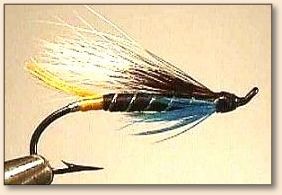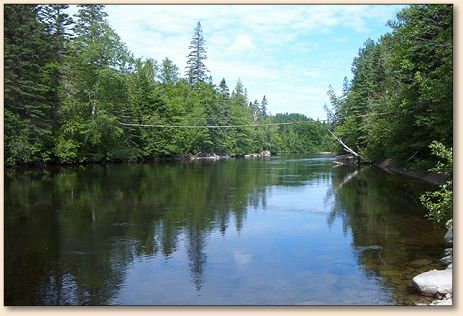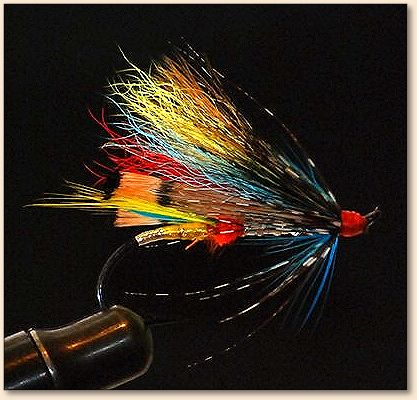Hooked for Life
By Chris Chin
I don't catch a lot of salmon. Not a very good declaration
coming from someone who guides occasionally! Then again, I
have been present when an awful lot of Atlantic salmon have been caught.
That said, it is pretty easy for me to remember the details of a
few memorable catches… especially that very first Atlantic.
I was showing to Liliane this week some flies we need to tie
up before the season starts (she's only been at it for 3 weeks
and already wants to attack some of my salmon flies.)
Anyway, I pull out "the examples box." The case which is original
flies tied by friends which I keep so that I can try to copy them. ALL
the flies which Manon C. sent to me are being conserved like this. This
method helps me to sort out the proportions and colors etc when my
creations start wandering down new trails.
I pull up an un-imposing #10 fly on a single salmon hook. It is a far cry
from the creations we saw in shadow boxes in Granby last week. The
fly is in "mint" condition. It has never been fished, but I have used many
many of its bigger brothers and smaller sisters over the years. Liliane
asks if it is a fly that can catch salmon here …
I first tied this fly on to my leader a few (many) years ago on my home
waters. The season was in its prime for adult salmon. Quotas were closing
up and down the river and there was one single salmon left to be taken in the
#2 zone. (this was back before 2002 when adult salmon were not mandatory
C&R).
As Serge had a friend on the #23, I decided to walk up to the #25 then
fish my way down to the #24. In the gleaming morning sun, I would have
preferred to fish dries, but wading upstream against the current for 300
yards is not my idea of fun. The water was about 1-2 feet up from normal,
so I knew that no one had fished this run for a few days (in other words,
no on was dumb enough to wade this stretch because the steep drop off
from the bank means that one false step and it's bath time).
I settled down on my butt in the sand on the beach of the #25 to think
strategy. The slick running from the 25 down to the 24 is long and wide.
In 3 different sections, a few boulders lay submerged and hidden with
the higher than normal water. It is amongst these boulders that "willing"
salmon often lay. I rummage around in the box of wet flies … nymphs
really and pull out a #10 sparely tied fly. Even though the salmon here
hadn't been cast to for a few days, they have been here for over a week
and have surely seen a few flies already.

A Blue Charm (Leigh Anderson)
At 7h00 I start casting. From the beach it is easy to present a normal
over head cast. In a few minutes I'll have to switch to roll casts once
I'm snugged up to the bank and overhanging branches. The salmon hold
dead center in the run, so the roll cast is really only about 50 feet.
I worked my way down the run, rather quickly for the first 50 yards.
When I started to get close to the second set of boulders, the attention
level ratcheted up a few notches. I had seen salmon holding downstream
the previous evening, so I just assumed that there were more here.
Standing in the river with water almost over my waist, I could not
see into the river enough to spot salmon here.
On the 3rd or 4th swing through the boulder garden, the line pulled
suddenly left and then down stream. No jump nor splash, the line
simply started playing out straight towards the next pool!

Looking upstream from the #23, past the 24 we can see the beach of the 25 in the far distance.
(This is roll casting territory!)
Now the problems start. Sure this is a lot of fun …my very first
Atlantic salmon. How am I supposed to get her back now? As the
backing keeps playing out, I know that she'll eventually get to the
next postal code. There is a big 'ole birch snag in the river bank that
I can't wade around to chase down the beast. I lift the rod to try and
pull her back, she pulls even harder and keeps unwinding the backing.
I try something that I had heard about. I walk upstream slowly. This
is called walking a salmon. Apparently, the tension on the line is different
when we walk backwards or something, because the darn animal just
sort of followed me back upstream. There is still plenty of tension on
the line, but she comes along anyway.
Twenty minutes later and the salmon is finally out and across from
me near the beach on the #25. I have some stable footing and can
see her holding 30 feet out from me … she is solidly seated in
the current. I pull towards me. Poof!
The fly, leader and line come looping back towards me. Lesson #1
for fighting a salmon … try to know which side of the mouth
the fly is anchored into. As she had turned to her RIGHT when she
ook the presentation, the fly was hooked into the left side of her mouth.
When I tried to pull her through the current, the fly literally pulled out
across her mouth!
Liliane comes up to me to show me the fly which she tied…

Her very first Atlantic salmon fly — I do believe the Gal is Hooked for Life!
~ Christopher Chin, Three Rivers Quebec.
About Chris:
Chris Chin is originally from Kamloops,
British Columbia. He has been fly fishing
on and off ever since he was 10 years old.
Chris became serious about the sport within
the last 10 years.
"I'm a forest engineer by day and part time
guide on the Ste-Marguerite River here in
central Quebec. I've been fishing this river
for about 10 years now and started guiding
about 5 years ago when the local guide's
association sort of stopped functioning."
Chris guides mostly for sea run brook trout
and about 30% of the time for Atlantic Salmon.
"I often don't even charge service fees, as
I'm more interested in promoting the river
than making cash. I like to get new comers
to realize that salmon fishing is REALLY for
anyone who cares to try it. Tradition around
here makes some of the old clan see Salmon
fishing as a sport for the rich. Today our
shore lunches are less on the cucumber sandwich
side and more toward chicken pot pie and Jack
Daniel's."
Chris is 44 years old as of this writing. He
is of Chinese origin although his parents were
born and raised in Jamaica.
To learn more about the Ste-Marguerite River,
visit Christopher's
website. You can email Chis at: Flyfishing.christopher@gmail.com.
Our Man In Canada Archives
|

